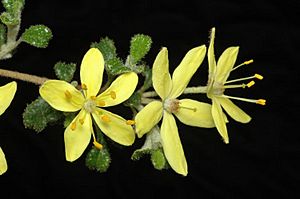Asterolasia buckinghamii facts for kids
Quick facts for kids Asterolasia buckinghamii |
|
|---|---|
 |
|
| In the ANBG | |
| Scientific classification | |
| Genus: |
Asterolasia
|
| Species: |
buckinghamii
|
| Synonyms | |
|
Phebalium buckinghamii Blakely |
|
Asterolasia buckinghamii is a type of tall, thin shrub. It belongs to the Rutaceae family, which also includes citrus plants. This shrub is special because it only grows naturally in eastern New South Wales, Australia. Its young branches have tiny hairs that look like stars. Its leaves are wide and egg-shaped, also covered in hairs. The flowers are yellow and have rusty-coloured, star-shaped hairs on the back of their petals.
Contents
About the Asterolasia buckinghamii Shrub
Asterolasia buckinghamii is a slender, upright shrub. It usually grows to be about 1.5 to 2 meters (5 to 6.5 feet) tall. Its young branches are covered with tiny hairs that look like stars.
Leaves of the Shrub
The leaves are shaped like a spatula or a wide egg. They are narrower at the bottom. Each leaf is about 4 to 15 millimeters long and 3 to 7 millimeters wide. They grow on a small stem called a petiole, which is 2 to 4 millimeters long. The leaves are also covered in star-shaped hairs. These hairs are very thick on the underside of the leaf. The top surface of the leaf has a long groove.
Flowers of the Shrub
The flowers grow either alone or in small groups of two or three. They appear where the leaves meet the stem, or at the ends of the branches. Each flower sits on a tiny stalk called a pedicel, which is up to 2 millimeters long. The flowers have five yellow petals. Each petal is shaped like an oval and is 4 to 8 millimeters long. The back of the petals is covered with rust-coloured, star-shaped hairs. Each flower also has ten stamens, which are the parts that produce pollen. This shrub flowers from October to November.
How it Got its Name
This plant was first described in 1940 by a scientist named William Blakely. He first named it Phebalium buckinghamii. He published his description in a magazine called The Australian Naturalist. The very next year, Blakely decided to change the name to Asterolasia buckinghamii. The second part of its name, buckinghamii, was chosen to honor "Mr. William J. Buckingham." He lived in Lindfield, New South Wales.
Where it Grows Naturally
Asterolasia buckinghamii grows in specific places in New South Wales. You can find it in wet areas like gullies and on flat land near rivers. It also grows on slopes close to the tops of cliffs. This shrub is found in the Wingello area. It also grows between the towns of Mittagong and Lithgow in New South Wales.

